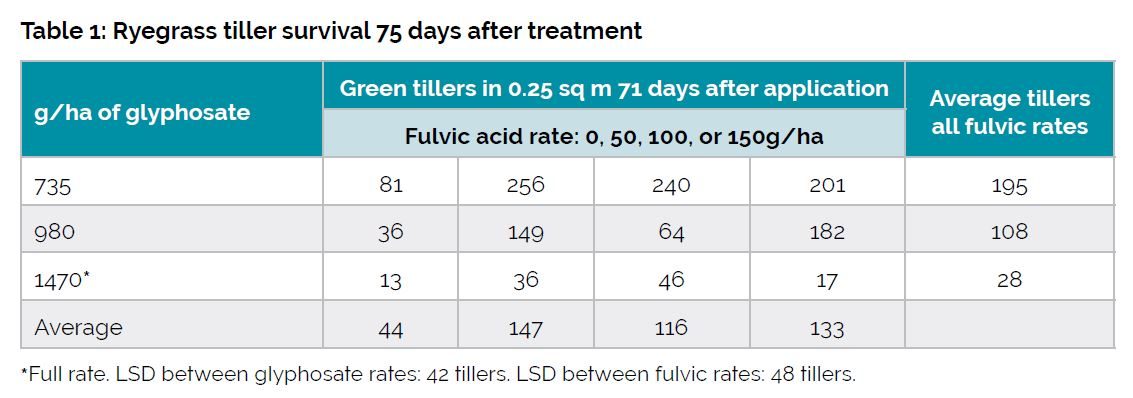By: Andrew Swallow
With glyphosate use under increasing public and regulatory scrutiny, not to mention resistance concerns, be extra careful when applying it, growers at FAR’s main agronomy event of the year, Crops 2020, were told.
“Glyphosate is under quite a lot of pressure worldwide. If we want to keep using it we need to make sure we get it right and get the best result every time we use it,” FAR’s Matilda Gunnarsson said.
However, in an effort to do that some growers have been using additives, which in FAR’s trials have failed to improve efficacy, and in some cases have even reduced it.
Last year’s results showed there was no benefit from adding fulvic acid alone or with citric acid, or using fish oil, ammonium sulphate, or the organo-silicone surfactant Pulse to glyphosate at a range of application rates, and in the case of fulvic acid, it actually increased survival of ryegrass tillers (see Table 1).
Speaking alongside Gunnarsson, Nu Farm’s Cynthia Christie said often the reason people gave for using such additives was that they dropped the pH of the spray solution, as glyphosate was known to work better in a slightly acidic solution, but unless a farm’s water was particularly hard (i.e. high pH) there was no need for the additive because glyphosate itself was a weak acid, and most formulations included buffers to make sure tank mixes were close to the optimum pH of about 4.5, she explained.
“There’s the odd situation where you have high pH water, for example when it’s drawn out of limestone, when there may be a case for adding a buffer but in New Zealand that’s a very rare situation,” she stressed.
Christie also said when there were problems with glyphosate efficacy it was often because of over-familiarity.
“One of the key things we see go wrong is that people have come to expect it to work every time but you still need to pay attention to the label.”
For example, because glyphosate’s activity was systemic, plants needed to be growing well and not stressed by drought or cold. There also needed to be an adequate amount of fresh growth for the plant to take up the chemical. If it had just been cut or grazed, results would be poor.
“The critical point with ryegrass is all tillers need 5cm to 10cm of new fresh leaf,” she commented, emphasising “all”.
“Ryegrass tillers don’t connect very well; they’re almost like individual plants, so chemical taken up by one tiller goes down into the roots but it won’t go back up into the tiller next to it.”
With perennial weeds such as docks, couch or Californian thistle, the time of year made a difference too. In spring such species were pushing reserves from roots to shoots, so getting glyphosate to go against that flow and kill roots was a challenge. Better control would be achieved in summer or early autumn when the plant was building, rather than drawing on, root reserves, provided the plant was still growing well, said Christie.
While FAR’s 2019 results hadn’t shown a benefit from using an organo-silicone adjuvant with glyphosate, it seems that was probably because of the timing of the trial. Christie stressed such adjuvants do help because they make applications rainfast sooner and improve efficacy on waxy leaved plants, such as ryegrass in spring.
The wax made it “almost impossible” to get glyphosate into the leaves’ epidermal cells from the leaf surface, but the organo-silicone adjuvant reduced the surface tension of the spray so it spread over the leaf, flooding through stomata into the interior of the leaf where there’s no waxy cuticle to prevent uptake, she explained.
But she warned against adding more than one adjuvant because often they were antagonistic.
“A mixture can unwind all the benefits of using the organo-silicone.”

Asked about what water rate to use, Christie said in general glyphosate works better with lower water volumes rather than higher – 100litres/ha rather than 300L/ha – but don’t go ridiculously low as that would require the spray to be super-fine and then drift becomes a problem. Also, the target needed to be taken into account – if there was a lot of foliage on the target, for example when using glyphosate before a silage cut, then increasing volume to 200L/ha “may make a positive difference”.
In FAR’s trials the rate of glyphosate itself used did make a significant difference to control; on average 28 tillers of ryegrass in a 0.25sq m quadrat surviving to eventually regrow following a full rate application, compared with with 195 from a half-rate (see Table 1).
“If you were ploughing you probably wouldn’t notice but if you were no-tilling then you’d definitely see that ryegrass coming up in your crop later on,” Gunnarsson said.
FAR is repeating the glyphosate additive trial this year, focusing on fulvic acid but using a liquid product instead of powdered.
Plots had been treated either five weeks or nine days before the field day, hence no results were available, though visual differences could be seen.
Glyphosate reminders
- Targets need fresh leaf and active growth.
- No need to acidify in most situations.
- Organo-silicone adjuvant enhances uptake, especially on waxy targets.
- Don’t use multiple adjuvants.
- Lower water volume usually better than high.





